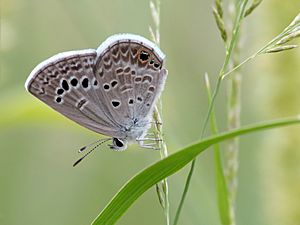Reakirt's blue facts for kids
Quick facts for kids Reakirt's blue |
|
|---|---|
 |
|
| Scientific classification | |
| Kingdom: | |
| Phylum: | |
| Class: | |
| Order: | |
| Family: | |
| Genus: |
Echinargus
Bálint, 1991
|
| Species: |
E. isola
|
| Binomial name | |
| Echinargus isola (Reakirt, [1867])
|
|
| Synonyms | |
|
|
The Reakirt's blue (scientific name: Echinargus isola) is a small, beautiful butterfly. It belongs to the Lycaenidae family, which is also known as the "gossamer-winged butterflies." This family includes many small and colorful butterflies.
The Reakirt's blue is special because it is the only butterfly in its group, called the Echinargus genus. This means it's the only species of butterfly that fits into that particular scientific category.
Contents
Where Reakirt's Blue Butterflies Live
These butterflies are mostly found in Central America. They also live in the very southern parts of the United States.
Amazing Journeys: Butterfly Migration
Reakirt's blue butterflies are known for traveling long distances. They regularly migrate across most of the United States. Sometimes, they even fly almost all the way to the Canada–United States border. It's rare, but they can also be seen in the southern prairies. This journey helps them find good places to live and lay their eggs.
How Big Are Reakirt's Blue Butterflies?
The Reakirt's blue butterfly is quite small. Its wingspan is about 16 to 23 millimeters. That's roughly the size of a small coin!
When to Spot Them
You can see adult Reakirt's blue butterflies flying at different times of the year. In the northern parts of their range, they are usually active from June to October. However, in the warmer southern areas, you might see them flying around all year long.
What Reakirt's Blue Butterflies Eat
The young butterflies, called larvae (or caterpillars), have a specific diet. They mostly eat plants from the Fabaceae family. This family includes many types of beans and peas.
Favorite Foods
One of their favorite foods is Mesquite plants. These plants are a type of tree or shrub that grows in dry areas. The caterpillars munch on the leaves of these plants to grow big and strong.

